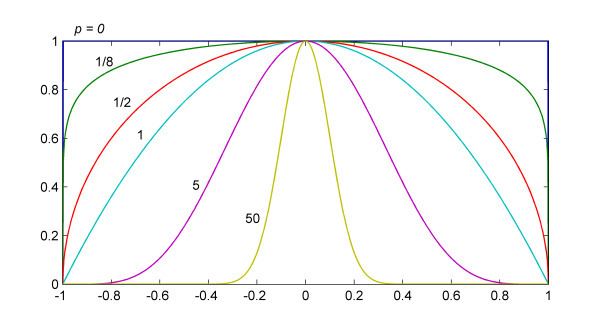 | ||
The superparabola is a geometric curve defined in the Cartesian coordinate system as a set of points (x, y) with
Contents
where p, a, and b are positive integers. The equation defines an open curve in the rectangle − a ≤ x ≤ a, 0 ≤ y ≤ b.
The superparabola can vary in shape from a rectangular function (p = 0) , to a semi-ellipse ( p = 1/2 ), to a parabola (p = 1), to a pulse function (p > 1) .
Mathematical properties
Without loss of generality we can consider the canonical form of the superparabola( a = b = 1)
When p > 0 the function describes a continuous differentiable curve on the plane. The curve can be described parametrically on the complex plane as
Derivatives of the superparabola are given by
The area under the curve is given by
where ψ is a global function valid for all p > − 1 ,
The area under a portion of the curve requires the indefinite integral
where
The centroid of the area under the curve is given by
where the
The nth (mathematical) moment is given by
The arc length of the curve is given by
In general, integrals containing
The arc length is
Generalization
A natural generalization for the superparabola is to relax the constraint on the power of x. For example,
where the absolute value was added to assure symmetry with respect to the y-axis. The curve can be described parametrically on the complex plane as well,
Now, it is apparent that the generalized superparabola contains within it the superellipse, i.e.,
The indefinite and definite integrals are given by
where
These results can be readily applied to the centroid and moments of the curve as demonstrated above by substitution of
History
The superellipse has been identified since 1818 as a Lamé curve. It appears that the superparabola was first identified by Löffelmann and Gröller. in their paper on superquadrics in conjunction with computer graphics. Waldman and Gray used the superparabola in their analyses of the Archimedean hoof. The "cylinder hoof", "hoof" or "ungula" was first formulated in a letter from Archimedes to Eratosthenes in the 3rd century BC and led to the classic Propositions 13 and 14 of The Method. This letter now transposed in Dijksterhuis is one of the most famous exchange of ideas in all history of mathematics.
Applications
The superparabola and its generalization have been applied to the Archimedean hoof. Briefly, the Archimedean hoof consists of a right cylinder with a footprint y = f(x) and height h that is cut by the plane z = h y . In the first image, the portion on the right is called the hoof, and is taken from the remaining half-cylinder leaving the complement . The base area, volume, and center of mass of both the hoof and the complement can be described solely in terms of the universal function, Ψ and height.
